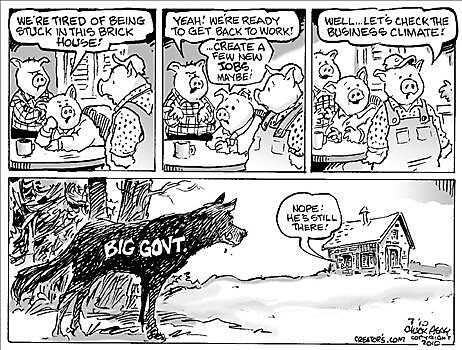Because of Obama’s class-warfare tax hike and additional tax increases by kleptocrats at the state level, many successful taxpayers will now lose more than 50 percent of any additional income they generate for the American economy.
I discuss the implications of this punitive tax policy in this CNBC interview.
Normally, this is the section where I highlight certain points I made, or bemoan the fact that I failed to mention an important fact or overlooked a key argument. Today, though, I want to address the do-taxes-impact-growth issue raised by Robert Frank.
More specifically, I want to debunk the Congressional Research Service study that he indirectly mentioned about two minutes into the segment. This is the report that asserted that it doesn’t matter if we impose high tax rates on investors, entrepreneurs, small business owners, and other “rich” taxpayers.
The results of the analysis suggest that changes over the past 65 years in the top marginal tax rate and the top capital gains tax rate do not appear correlated with economic growth. The reduction in the top tax rates appears to be uncorrelated with saving, investment, and productivity growth. The top tax rates appear to have little or no relation to the size of the economic pie.
The good news is that I don’t really need to debunk this CRS study because Steve Entin already has undertaken that unpleasant task. Writing for the Tax Foundation, Steve points out some rather fatal flaws in the CRS study.
The study makes no effort to determine the channels through which the tax changes ought to work to affect the economy, looks at the wrong measure of progress over the wrong time frame, and takes inadequate account of what other tax or economic events are occurring at the same time that might mask the results. …Other changes in taxes and other influences on the economy occurring at the same time can easily hide or counteract the effect of the top tax rate changes alone. It is often impossible to hold other things constant to allow one to see the impact of the single item one wants to assess. When these other influences are omitted from the model, the “missing variables” problem poisons the results. …one should look at the long-term change in the capital stock and the ultimate level of output, not the short-term rise in investment and the short-term change in the growth rate. If one looks only at the growth rate, and not at the level of GDP, one could conclude that the tax rate change has only a temporary benefit, when in fact it is permanently helpful. …Looking only at the amount of investment triggered in the year following the tax change misses the point. The same holds true in the opposite direction for a tax increase. It takes years to retire through attrition the excess capital made redundant by a tax increase. Looking only at the change in investment in the year after the tax cut, rather than the cumulative increase in the stock of capital over time, misses about 95 percent of the impact. You can’t predict this fall’s apple crop by counting the number of seedlings planted this spring.The CRS study omits important variables and poisons its results by not holding other factors constant. The variables it does examine are indirectly related to the relationship one should be studying, but the study does not follow them for long enough to get the whole picture. The study is as weak now as it was when it was first issued. Grade: F.
By the way, the Wall Street Journal pointed out that the author of the CRS study is not exactly dispassionate and neutral on these matters.
You won’t be surprised to learn that Mr. Hungerford has donated to the Obama campaign and Senate Democrats and worked as an economist at the White House budget office under Bill Clinton.
In closing, I did address the taxes-growth issue last year. I wasn’t debunking the CRS study, but I was exposing the errors in some very similar analysis by a writer for the New York Times.
Here’s the key passage from that post.
Yes, lower tax rates are better for economic performance, just as wheels matter for a car’s performance. But if a car doesn’t have an engine, transmission, steering wheel, and brakes, it’s not going to matter how nice the wheels are.
In other words, I was focusing on the fact that you can’t accurately and honestly examine tax policy without looking at the impact of other public policy issues.
I made that point in the CNBC interview, of course, though it’s unclear whether the message got through.
But I think the Clinton years and Bush years make my point. Bill Clinton was bad on tax policy in 1993, but was good on almost everything else (including a cut in the capital gains tax rate in 1997), whereas George W. Bush was okay on tax policy, but was bad on just about everything else.
So here are a couple of very simple questions.
- Given what we now know about the increase in economic freedom under Clinton and the loss in economic freedom under Bush, is anybody surprised that the economy did better under Clinton than it did under Bush?
- Does anybody think that the economy prospered under Clinton because he raised tax rates in 1993?
- Does anybody think the economy was anemic under Bush because he lowered taxes in 2001 and 2003?
Depending on how you answer those questions, you may be qualified to work at the Congressional Research Service.
But if you understand that it’s important to look at the overall burden of government when measuring the impact of public policy on economic performance, then…well, I’m not sure whether I can promise anything other than you’ll have the satisfaction of knowing that you’re intellectually honest and economically literate.

